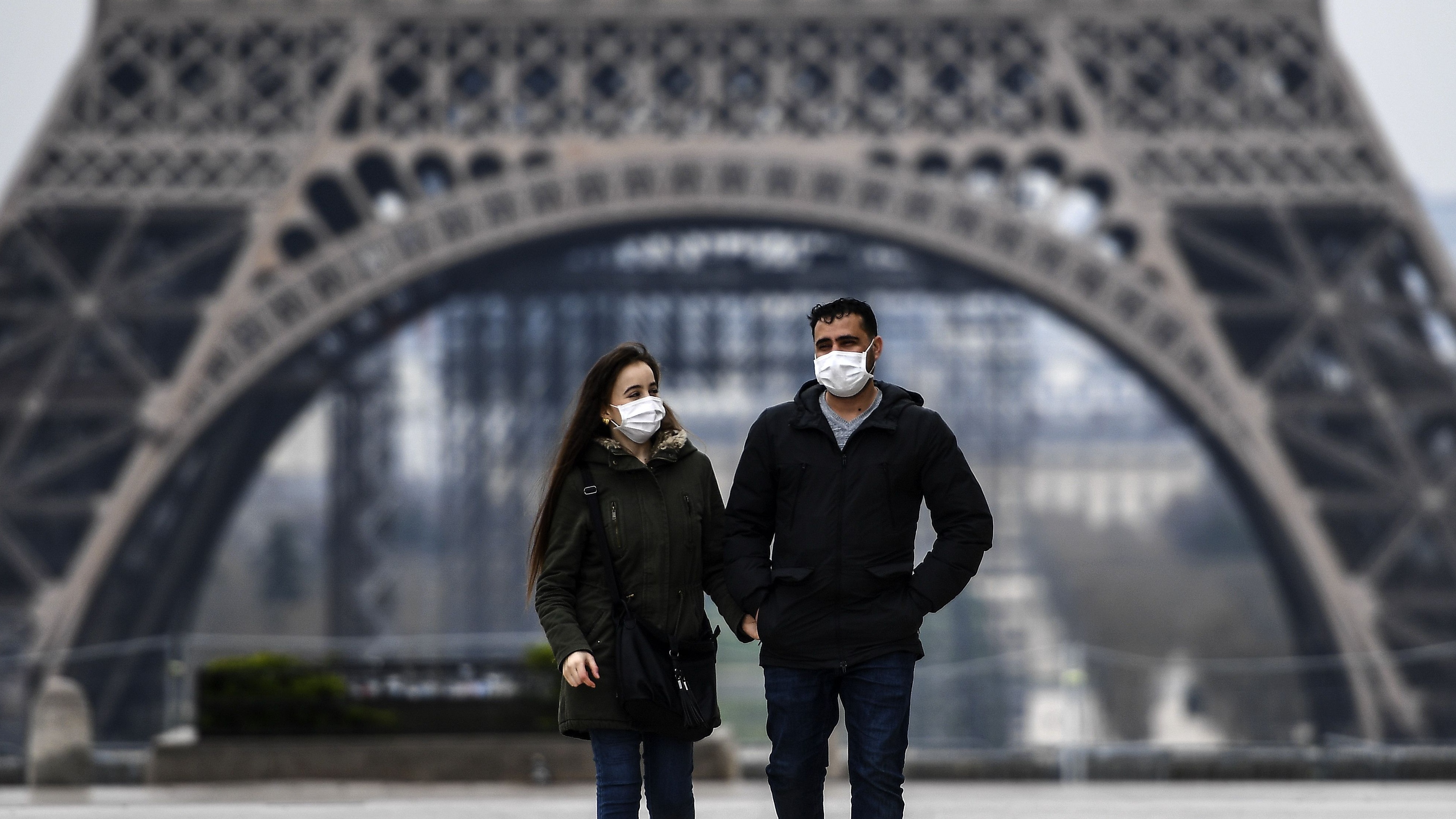Coronavirus: how relaxing lockdown rules has impacted Europe
UK lagging behind on lifting restrictions

Millions of Europeans are welcoming the easing of stay-at-home orders, as countries across the Continent take tentative steps towards lifting lockdowns.
Officials will be monitoring the impact of the relaxations, with leaders ready to hit the pause button if coronavirus infection rates begin to climb once again in their countries.
So just which restrictions are being lifted - and how have the changes affected the number of Covid-19 cases being recorded?
The Week
Escape your echo chamber. Get the facts behind the news, plus analysis from multiple perspectives.

Sign up for The Week's Free Newsletters
From our morning news briefing to a weekly Good News Newsletter, get the best of The Week delivered directly to your inbox.
From our morning news briefing to a weekly Good News Newsletter, get the best of The Week delivered directly to your inbox.
Germany
Germany is weeks into a phased reopening of its economy that began on 20 April, when small shops were allowed to reopen.
Stores of all sizes have been permitted to open their doors since last week, and schools have been partially reopened for young children and those taking exams. Other year groups are due to return to school gradually over the summer term.
The government has also granted permission for people from two separate households to meet up with each other, but big public events such as festivals and concerts will remain banned until at least the end of August.
A free daily email with the biggest news stories of the day – and the best features from TheWeek.com
However, Bundesliga football matches will restart behind closed doors on 16 May - the first of the major European leagues to kick off since the pandemic suspended team sports across the Continent.
Germany has seen a slight rise in its R value - the average number of people that one infected person will go on to infect - since the authorities began relaxing the restrictions. The R value reached around 1.1 in Germany on Saturday, but officials warned of “insecurities” in predicting a long-term trend, reports Deutsche Welle.
France
France has also begun to lift strict lockdown measures that have been in place since 17 March.
From this week, citizens are allowed to go out without certificates of permission, and to travel up to 100km (62 miles) from their homes by car, says the BBC. Longer trips still require a certificate, and commuters travelling in the Paris rush hour still need their employer’s authorisation or a compelling reason to travel.
Four “red zones” - including Paris - will remain under a stricter lockdown, with parks, gardens and schools for children aged between 11 and 18 staying shut.
But in “green zones”, primary schools and nurseries are starting to reopen from today, while schools for 11- to 15-year-olds will open again on 18 May. A limit of 15 pupils will be applied in classrooms, and masks will be required for older children.
Schools for 15- to 18-year-olds will not open until June, at the earliest.
All shops other than Paris shopping centres can now open, as can leisure centres and cemeteries, and gatherings of fewer than ten people are permitted.
However, bars and restaurant remain closed.
On 1 May, France’s public health chief said the R value in the country had risen from 0.5 to between 0.6 and 0.7 on average as a result of the “progressive return to activity”.
But, crucially, the value remains below 1 - and “officials are not solely relying on the R, instead reviewing several indicators to decide when to loosen restrictions,” says The Telegraph.
Spain
After implementing one of the toughest lockdowns in Europe, the Spanish authorities began a phased lifting of the measures on 4 May. Restrictions will continue be eased in two-week blocks until 10 June, but the plan may be paused or reversed if cases spike.
Schools will partially reopen from 26 May to allow for revision classes and state exams, but a full reopening is not expected until September.
From today, customers can order a beer in a terrace bar, but bars and restaurants will not fully reopen until 10 June.
Cinemas, theatres and exhibitions will be allowed to open at 30% capacity from 26 May.
Churches and mosques can also open at partial capacity as of this week, and groups of up to ten people are allowed to meet in homes or outdoors - to the delight of many.
“We have already set a date for dinner on Wednesday, just ten of us. I can’t wait to touch someone, to kiss and be kissed,” 66-year-old Beatriz Gonzalez, who lives in the city of Las Palmas in the Canary Islands, told The Guardian.
Spanish officials are now monitoring the country’s R value, which stood at below 1 as of the end of April.
Ireland’s lockdown has been even stricter than that in England, with residents only permitted to exercise within 1.2 miles of their homes.
But the country is planning to start relaxing lockdown laws from 18 May, when outdoor workers such as construction workers and gardeners will be allowed to return to their jobs.
Creches and nurseries will reopen for the children of essential workers from 29 June, and for all workers from 20 July. However, schools will not reopen until September.
Social visits between households will be allowed from 8 June, and from 29 June people will be permitted to travel within a 20km (12-mile) radius of their homes.
Weddings, baptisms and small social gatherings will be allowed from 20 July, but only for family and close friends, reports the BBC.
Small shops selling non-essential items will be allowed to reopen from 8 June, and larger shops can open their doors from 29 June.
Speaking in Dublin on Sunday, the Irish Health Service Executive’s chief clinical officer, Dr Colm Henry, said that an estimated 10,000-plus lives had been saved and the R value significantly decreased as a result of the lockdown measures, reports the Irish Mirror.
“The R value is dipping well below 0.8. If that R value had remained at 2.4, we would have been seeing on 7 May 12,000 deaths instead of almost 1,200,” Henry said.
Over the border in Northern Ireland, Arlene Foster announced that the R value in her country is currently at around 0.8 or 0.9, reports The Irish News.
That compares with an R value in England of between 0.5 and 0.9, according to figures shared by Foreign Secretary Dominic Raab last week.
–––––––––––––––––––––––––––––––For a round-up of the most important stories from around the world - and a concise, refreshing and balanced take on the week’s news agenda - try The Week magazine. Start your trial subscription today –––––––––––––––––––––––––––––––
Italy was one of the earliest countries in Europe to be hit by the Covid-19 coronavirus, with thousands of people infected before the severity of the crisis was fully understood.
However, as the outbreak in Italy eases, the authorities have lifted earlier measures preventing people going more than 200m from their homes. Since early May, citizens have been permitted to travel longer distances and to visit their relatives in small numbers.
Visiting people in other regions is still banned.
From 18 May, shops, museum and libraries will be allowed to open, and sports teams to train together. Bars, restaurants, hair dressers and beauty salons are set to fully reopen from 1 June.
But schools will remain closed until September.
Italian officials are using the R value as their key guidance in which measures should be lifted or remain in place. As of 2 May, the key figure stood at around 0.7.
“It’s important not to let down our guard,” said Silvio Brusaferro, president of the Italian Higher Health Institute.
Sweden
Sweden is something of an anomaly in Europe, because “strictly speaking, there was no real lockdown, so Sweden does not have much to remove” says the BBC.
Restaurants, bars, schools and businesses have remained open throughout the pandemic, although a ban on gatherings of more than 50 people was introduced in late March.
Whether Sweden’s relaxed approach has paid off is questionable. The country has recorded more than 3,200 deaths, by far the highest per capita number compared with the other Nordic countries.
And while the Swedish economy has weathered the coronavirus storm better than most so far, experts say that may not prove to be the case in the long term.
“Early figures for Sweden’s gross domestic product in the first quarter of 2020, released this week, suggested that at least in March it had performed better than much of the EU as it recorded a decline of just 0.3%, compared with a 3.8% fall for the eurozone,” reports the Financial Times.
“But economists argue that Sweden is unlikely in the long term to escape the severe economic pain of the rest of Europe. The European Commission forecasts that Sweden’s GDP will fall by 6.1% this year.”
-
 The best homes of the year
The best homes of the yearFeature Featuring a former helicopter engine repair workshop in Washington, D.C. and high-rise living in San Francisco
-
 Critics’ choice: The year’s top 10 movies
Critics’ choice: The year’s top 10 moviesFeature ‘One Battle After Another’ and ‘It Was Just an Accident’ stand out
-
 The small Caribbean island courting crypto billions
The small Caribbean island courting crypto billionsUnder the Radar Crypto mogul Olivier Janssens plans to create a libertarian utopia on Nevis
-
 ‘Lumpy skin’ protests intensify across France as farmers fight cull
‘Lumpy skin’ protests intensify across France as farmers fight cullIN THE SPOTLIGHT A bovine outbreak coupled with ongoing governmental frustrations is causing major problems for French civil society
-
 How Bulgaria’s government fell amid mass protests
How Bulgaria’s government fell amid mass protestsThe Explainer The country’s prime minister resigned as part of the fallout
-
 Femicide: Italy’s newest crime
Femicide: Italy’s newest crimeThe Explainer Landmark law to criminalise murder of a woman as an ‘act of hatred’ or ‘subjugation’ but critics say Italy is still deeply patriarchal
-
 Brazil’s Bolsonaro behind bars after appeals run out
Brazil’s Bolsonaro behind bars after appeals run outSpeed Read He will serve 27 years in prison
-
 Americans traveling abroad face renewed criticism in the Trump era
Americans traveling abroad face renewed criticism in the Trump eraThe Explainer Some of Trump’s behavior has Americans being questioned
-
 Nigeria confused by Trump invasion threat
Nigeria confused by Trump invasion threatSpeed Read Trump has claimed the country is persecuting Christians
-
 The Louvre’s security measures are in hot water after a major heist
The Louvre’s security measures are in hot water after a major heistIn the Spotlight Millions of dollars in jewels were stolen from the museum
-
 Daylight saving time: a Spanish controversy
Daylight saving time: a Spanish controversyUnder the Radar Spain’s prime minister has called on the EU to remove biannual clock changes in Europe